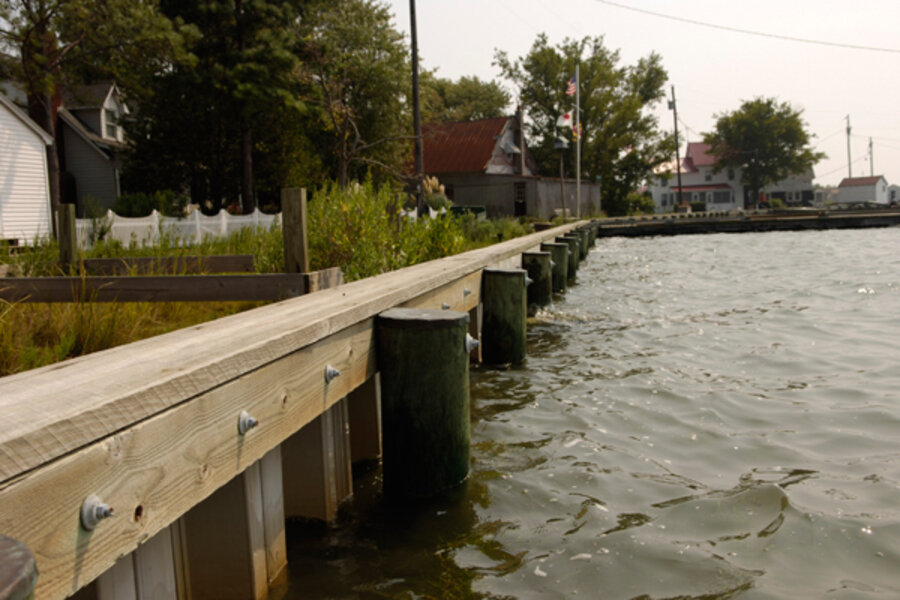March and April warmest ever. Humans must adapt, report says.
Loading...
Against a backdrop of the warmest March and April on record globally, the US National Research Council on Wednesday called for accelerated action to curb greenhouse gases, greater emphasis on research into technologies that will help wean the US from its fossil-fuel habit, and more focus on adaptation to global warming.
The conclusions and the scientific results backing them appear in three volumes the council released Wednesday, with two more due out later this year. Congress requested the reports in 2008 to help set out choices the country faces in its efforts to deal with global warming.
Climate change is occurring, it's largely caused by human activity, and the US already is experiencing consequences, explains Pamela Matson, dean of Stanford University's School of Earth Sciences. She chaired the panel reviewing the latest scientific results.
The future "is where there are a lot of scientific uncertainties," she says.
Over the past decade, climate models have suggested global average temperatures could rise two to 11 degrees Fahrenheit over preindustrial levels by the end of the century. The reason behind the wide temperature spread has as much to do with uncertainties about people's response to the challenge as it does with unresolved questions scientists have about processes driving climate change.
But despite those uncertainties, "the risks are clear," Ms. Matson says – from sea-level rise and changes in water available for farming, industrial, and residential use to carbon dioxide's measurable effect in acidifying the oceans. The global warming challenge "becomes a sustainability challenge," she says.
At one level, the conclusions hold no surprises. Although they capitalize on research results that have appeared since the last set of reports from the embattled Intergovernmental Panel on Climate Change in 2007, they carry an air of 'been there, heard that.'
"I must admit there is that kind of consistency" in the messages the reports carry, says Jack Fellows, vice-president for corporate affairs at the University Corporation for Atmospheric Research (UCAR), a 100-institution consortium that runs the National Center for Atmospheric Research. "You could look at this as a yawner, or you could look at this as: 'This isn't going away.' "
While action on climate change in general and adaptation in particular are slow at the federal level, several state and local governments aren't waiting for Washington to act, says Dr. Fellows, who has been working with cities such as Chicago and New York on global-warming adaptation. Players at those levels who are responsible for keeping roads and bridges open during severe weather, ensuring water flows through taps, or providing adequate public-health services and facilities tend to fall into the "isn't-going-away" camp.
Indeed, the National Research Council focused one of its volumes on climate change adaptation and a glaring gap in adaptation-related research. The issue is particularly challenging in the US because of the country's size and and diversity of climate regimes it embraces – from the polar to the subtropical.
Experience dealing with floods, heat waves, and droughts gives US decisionmakers many options to consider, says Thomas Wilbanks, who heads the global change and developing countries program at the Oak Ridge National Laboratory in Oak Ridge, Tenn. One challenge: "If climate change takes us beyond the envelope of historical experience, the options we know about now may not be adequate," says Dr. Wilbanks, who led the team producing the NRC volume on adaptation.
Clinging to "known options" could lead to what he calls mal-adaptation. For instance, he says, the current definition of the expanse of flood plains along rivers inundated in a once-in-a-100-year flood "is way behind recent evidence about flooding dangers." The federal government is using the latest technology to develop more accurate elevation maps along rivers. But the frequency and intensity of flooding appears to be changing as well in some areas, and researchers say it's unclear the latest hydrology information is being folded into the new flood-hazard maps.
Depending on location, communities can begin to take simple steps, which start with figuring out what sort of vulnerabilities they may face under a range of global warming scenarios, Wilbanks says. Some of these can be offset by what he calls incremental steps.
Incremental steps clearly won't work in other situations, he adds, citing the Gulf Coast as an example. Federal estimates suggest that by 2050, sea level rise along stretches of the Gulf Coast could range from two to four feet, a figure that includes the effects of natural and human-triggered subsidence.
Over the short term, he says, it may be possible to make due with seawalls, hardening structures to withstand coastal flooding from storms, and other approaches. "But the longer-term response may need to consider some movement of infrastructure and even human settlements away from vulnerable areas," he says.
"Clearly, where more-severe climate-change impacts are a possibility, we need to start some serious contingency planning soon," as well as boost research on the implications of those effects and approaches to dealing with them, Wilbanks says.
Adaptation doesn't need a federal response, "it needs a national response," he says – one that involves virtually every segment of the public and its political institutions.
One step in that direction is scheduled to take place next week in Washington – the nation's first climate-adaptation summit. It's been organized by UCAR and the White House Office of Science and Technology Policy. The two-day meeting will bring together those who do the research with those interested in using the results of the research in adaptation planning, UCAR's Fellows says.
"In many respects, the states are out in front of the federal government," he says. It's time to bring all those voices in and say: 'Federal government, here's how you can help us.' "
Related:





